
Murray Hill is a neighborhood on the east side of Manhattan in New York City. Murray Hill is generally bordered to the east by the East River or Kips Bay and to the west by Midtown Manhattan, though the exact boundaries are disputed. Murray Hill is situated on a steep glacial hill that peaked between Lexington Avenue and Broadway. It was named after Robert Murray, the head of the Murray family, a mercantile family that settled in the area in the 18th century.
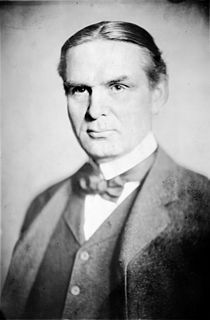
Ernest Flagg was an American architect in the Beaux-Arts style. He was also an advocate for urban reform and architecture's social responsibility.

The Marcy Avenue station is a station on the BMT Jamaica Line of the New York City Subway. Located at the intersection of Marcy Avenue and Broadway in Brooklyn, it is served by the J train at all times, the M train at all times except late nights, and the Z train during rush hours in the peak direction.
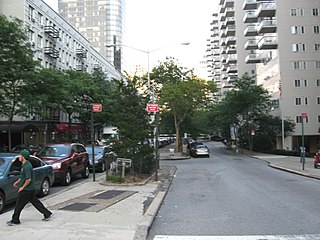
66th Street is a crosstown street in the New York City borough of Manhattan with portions on the Upper East Side and Upper West Side connected across Central Park via the 66th Street transverse. West 66th Street is notable for hosting the Lincoln Center for the Performing Arts between Broadway and Columbus Avenue.

Stuyvesant Square is the name of both a park and its surrounding neighborhood in the New York City borough of Manhattan. The park is located between 15th Street, 17th Street, Rutherford Place, and Nathan D. Perlman Place. Second Avenue divides the park into two halves, east and west, and each half is surrounded by the original cast-iron fence.
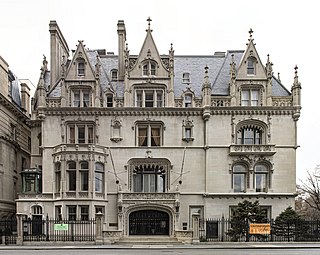
The Harry F. Sinclair House is a mansion at the southeast corner of East 79th Street and Fifth Avenue on the Upper East Side of Manhattan in New York City. The house was built between 1897 and 1899. Over the first half of the 20th century, the house was successively the residence of businessmen Isaac D. Fletcher and Harry F. Sinclair, and then the descendants of Peter Stuyvesant, the last Director of New Netherland. The Ukrainian Institute of America acquired the home in 1955. After the house gradually fell into disrepair, the institute renovated the building in the 1990s. The house was added to the National Register of Historic Places (NRHP) and was named a National Historic Landmark in 1978.

William Street is a street in the Financial District of Lower Manhattan, New York City. It runs generally southwest to northeast, crossing Wall Street and terminating at Broad Street and Spruce Street, respectively. Between Beaver Street and Broad Street, the street is known as South William Street. Between Beekman Street and Spruce Street, in front of New York Downtown Hospital, William Street is a pedestrian-only street.

Dey Street is a short street in Lower Manhattan, in New York City. It passes the west side of the World Trade Center site and the World Trade Center Transportation Hub. It runs for one block between Church Street and Broadway. It originally ran to West Street, but the western reaches were demolished to make way for the World Trade Center in the late 1960s. It now extends to Greenwich Street. 15 Dey Street is the site of the first transcontinental telephone call.
Marc Eidlitz was a builder active in New York City, where he was prominent in the construction industry, in partnership with his son Otto Eidlitz (1860–1928).

William Wheeler Smith, AIA, professionally known as "W. Wheeler Smith," was an American architect and developer active in late-nineteenth- and early-twentieth-century New York City. His home office was located at 17 East 77th Street, New York City. He previously occupied 971 Madison Avenue.

The Stuyvesant Fish House is a brick and limestone Italianate mansion located at 25 East 78th Street, at the corner of Madison Avenue in New York City. It was constructed for railroad executive Stuyvesant Fish and designed by Stanford White of McKim, Mead and White in 1898.
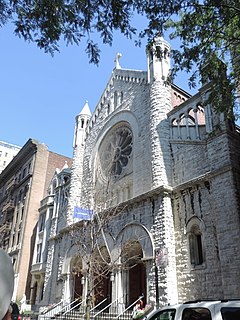
The Church of the Ascension is a Roman Catholic parish church in the Roman Catholic Archdiocese of New York, located at 221 West 107th Street in the Manhattan Valley section of the Upper West Side of Manhattan, New York City. The parish was established in 1895.

George W. Keister was an American architect. His work includes the Hotel Gerard (1893), Astor Theatre (1906), Belasco Theatre (1907), the Apollo Theater (1914), the Bronx Opera House (1913), the Selwyn Theatre (1918), now known as American Airlines Theatre, and the First Baptist Church in the City of New York. He also designed Woodbridge Hall at 431 Riverside Drive (1901), which faced demolition in 1996, and the Sigma Chi Fraternity at 565 W. 113th St. (1903).
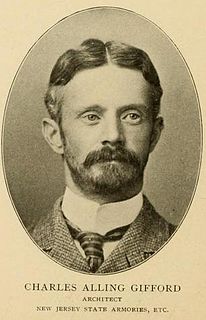
Charles Alling Gifford was an American architect and a partner in the New York City firm of Gifford & Bates. He is best remembered for his resort hotels, but also designed houses, churches, and five armories for the New Jersey National Guard.

Frank Aydelott Rooke, known professionally as Frank A. Rooke, was a New York architect who designed the historic Claremont Riding Academy and numerous other structures of significance that are either in National Historic Districts or listed on the National Register of Historic Places in the tri-state area.

Charles T. Mott was an architect in the U.S. He designed many rowhouses in Manhattan, New York City and Halliehurst (1890), for businessman and government official Stephen Benton Elkins who later became a U.S. Senator. Halliehurst is in what is now Elkins, West Virginia and is part of the Davis & Elkins College campus. He also designed an annex to the Seville Hotel building and many West Side Rowhouses in Manhattan, New York City. He was a fellow in the American Institute of Architects.
Harry Allan Jacobs (1872–1932) was an American architect from New York City. He designed the hotel building at 22 East 29th Street, now the James New York - NoMad, a New York City Landmark. He also designed Hotel Marseilles (1905), a New York City Landmark, and the wings added to 1125 Grand Concourse.
Nicholas William Stuyvesant was a New York landowner and merchant who was a great-great-grandson of Peter Stuyvesant, the last Dutch Director-General of New Amsterdam.
Stockton Beekman Colt was an American architect noted for using the Renaissance style. He designed the Barclay Building, Nathaniel L. McCready house, and the Emmet Building in New York City.

















